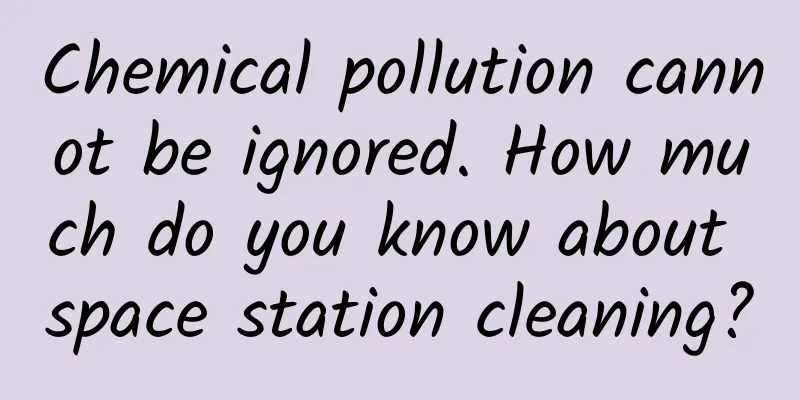Chemical pollution cannot be ignored. How much do you know about space station cleaning?

|
Recently, a study showed that the concentration of potentially harmful chemical pollutants on the International Space Station has exceeded the concentration of similar substances in the floor dust of American and European households. Astronauts' life in space has always attracted widespread attention. So what environmental pollution challenges are they likely to encounter during their regular stay in space? How can researchers and astronauts solve these problems? Potential hidden dangers cannot be ignored Recently, a joint research team from the University of Birmingham in the UK and NASA's Glenn Research Center published a paper in the journal Environmental Science & Technology Letters stating that the concentration of harmful chemical pollutants on the International Space Station has reached a level that cannot be ignored. In 2019, astronauts collected a large amount of gas, dust, hair, lint and other materials from the air filters of the International Space Station. Later, the research team measured the concentration of harmful chemicals in these materials and found that the types of pollutants contained were quite complex and diverse, mainly including polybrominated diphenyl ethers, brominated flame retardants, organophosphates, polycyclic aromatic hydrocarbons, polychlorinated biphenyls and perfluoroalkyl substances. There are many potential sources of contamination inside the aging International Space Station Although the study concluded that pollutant concentrations were "still within normal ranges," they were above the median concentrations of harmful substances in dust in homes and other indoor environments in the United States and Western Europe. So how come there are so many harmful compounds on the International Space Station? It turns out that as the space station has been in orbit for a long time, various base materials, electronic instruments, furniture, fabrics, etc. have accumulated more and more in the sky, and the potential pollution threat has gradually emerged. Although the International Space Station is equipped with an air filtration system that can efficiently remove some pollutants in the gas, and can also rely on the air flow system to drive and absorb suspended particles in the air, researchers still have insufficient research on the high-intensity abnormal ionizing radiation that may appear in space. Will it cause the concentration of harmful chemicals remaining in the air inside the space station to further increase, or even exceed the normal range, threatening the life and health of astronauts? Researchers still need to explore this issue in depth over a long period of time. Be careful with protective materials The above-mentioned harmful chemicals are accumulated over the life of the International Space Station and seem to be unavoidable. However, researchers and astronauts will not miss any details in their work and do their utmost to eliminate various pollution factors and hidden dangers. For example, fire is a major threat to life safety. Thick smoke releases toxic substances and threatens respiratory health. The space station provides astronauts with a safe space isolated from outer space. Many scientific experimental instruments are arranged in the relatively small cabin. Once a fire occurs accidentally, the safety structure of the space station may be destroyed, threatening the life safety of astronauts. In order to prevent fire, researchers will repeatedly and thoroughly screen structural materials, experimental instrument substrates, etc. during the design and construction of the space station, paying attention to flame retardant properties. In addition, flammable materials such as fabrics in the space station are also different from those on Earth, and generally contain certain inorganic flame retardants, including handrails and foot limiters, seats, cushions, etc. that assist astronauts in drifting. However, traditional flame retardant materials may also produce substances such as polybrominated diphenyl ethers and organophosphates that are harmful to the human body. This has also become an important factor that must be considered when designing the new generation of manned spacecraft. In addition, the space station has sealing rings and sealants in the docking mechanisms, airlocks, porthole structures, etc. of each cabin to ensure airtightness. However, sealants often produce polychlorinated biphenyls. If the content exceeds the allowable range, it may affect the astronauts' skin tissue, respiratory and digestive systems, etc. Although the concentration of polychlorinated biphenyls in the International Space Station has been tested many times and is within the normal range, this potential threat cannot be ignored and has caused a lot of concern. Astronauts' lives are becoming more and more personalized, and it is not new to bring clothes from Earth to space, but the perfluoroalkyl substances in them are worthy of vigilance. Therefore, it is necessary to carefully test the astronauts' daily necessities and experimental instruments and equipment shipped from Earth to minimize potential chemical pollutants. Technology helps boost safety Taking into account the diversity of potential space pollutants, in order to ensure the health and safety of astronauts, protective decontamination methods must also be flexible, mainly including two categories: initial source control and intermediate process isolation. At the beginning of the design and construction of the space station, scientific researchers must screen insulation materials, structural substrates, etc., collect information extensively, eliminate materials that may produce excessive chemical pollutants discovered in previous studies, and give priority to the use or development of pollution-free, chemically stable materials to reduce chemical pollutant emissions from the source. In addition, materials will inevitably decompose under the extremely harsh conditions of outer space, so it is important to reduce the probability of them producing harmful gases. With the development of technology, more and more new materials with stable chemical properties and excellent structural strength characteristics are being used in the construction of space stations. In space, without the protection of the atmosphere, ionizing radiation and abnormal ionizing storms are "rampant", which will inevitably accelerate the aging of plastic products, rubber products, electronic component substrates, etc. on the space station. Solar storms and strong ionizing radiation in outer space can affect the normal operation of spacecraft and reduce the quality of satellite communications in a short period of time. More powerful cosmic rays and solar ions may even damage the external structure of spacecraft and threaten the service life of spacecraft. Therefore, adding protective materials to the outer wall of the space station structure can not only provide operational safety, but also absorb ion waves, weaken the decomposition and catalytic reaction of ionizing radiation on various materials in the space station, and reduce the probability of producing chemical pollutants. Studies have shown that electronic components release harmful chemicals during use, which may cause certain chemical pollution. If the space station is fully equipped with environmentally friendly materials, the pollution process can also be slowed down. As for the chemical pollutants already present in the air inside the space station, they are usually removed by filtration and adsorption. After all, the space station requires a closed environment and windows cannot be opened for ventilation. Under microgravity conditions, the flow of chemical pollutant particles is mainly driven by the ventilation system. If astronauts want to remove suspended pollutant particles in the air in a timely manner, they need to use a powerful air circulation system to make the suspended matter and particulate matter in the air eventually gather at the ventilation grille collection point, helping the air purification system to dispose of them efficiently. Even so, as impurities suspended in the air gather at the ventilation grilles under the action of the air circulation system, unpredictable hidden dangers are inevitable. Astronauts must regularly clean up remaining sediments and impurity particles, and disinfect items they have touched in a timely manner to reduce the probability of bacterial contamination. As the construction of the new generation of space stations progresses and their regular operation, human experience and understanding of space life continue to deepen. Technological achievements such as space environment monitoring, aerospace materials, life support systems, special cleaning agents, and cleaning robots are gradually emerging. The cleanliness of the space station will be further improved, providing more reliable protection for astronauts' work and life in orbit. (Author: Cai Yang, Image source: NASA, Gatekeeper expert: Jiang Fan, deputy director of the Science and Technology Committee of China Aerospace Science and Technology Corporation) |
>>: Massaging the neck can cause cerebral infarction! Can you still enjoy massage?
Recommend
Crow redeems emotions "Combo 3.0"
Crow Redemption Emotion "Combo 3.0" Res...
What is the relationship between Zhu Yuanzhang and Bach?
Leviathan Press: In 1616, the year Shakespeare di...
How to effectively improve your product conversion rate? 3 case studies!
As China's Internet demographic dividend grad...
Pineapple Season Edition Ye Tan Wine Bureau Pineapple Cloud Wine Bureau (Season Edition)
Pineapple Season Edition Ye Tan Wine Bureau Pinea...
He Wei Element Flow Yoga System Basic Teacher Training
Introduction to the basic teacher training resour...
Tao Ge's "Love Map" Baidu Cloud Download
Tao Ge's "Love Map" Resource Introd...
Three steps to launch the event!
Event operation is different from content operati...
Starting from March 1st, there is no need to repeat the examination when changing hospitals! Which specific diseases require repeated examinations? Attached is the original policy!
In order to reduce the problem of repeated examin...
Capital cooling, it’s time to tear off the veil of “pseudo-intelligence”
Recently, a list of the death of smart hardware w...
Analysis of the Douyin app operation and promotion plan!
Short videos have become the hottest track in rec...
Take you to catch the "ghost" in the fossil
Produced by: Science Popularization China Author:...
Two iPhones and a Watch: Apple's "late" press conference
In September, a month full of new phones, after m...
How to operate a product well with insufficient budget?
Insufficient funds is a common problem faced by m...
Characteristics of several common distribution channels such as Weibo and Tik Tok!
If you choose the right promotion channel , you w...
There are so many stars in the universe, why is the sky dark at night?
On a clear, cloudless night, if you come to the c...









